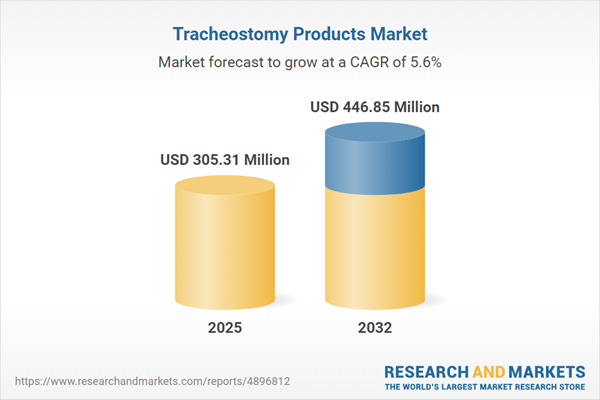Speak directly to the analyst to clarify any post sales queries you may have.
The tracheostomy products market is undergoing pivotal changes as healthcare providers adapt to new technologies, regulatory standards, and shifting patient needs. Senior decision-makers now require focused intelligence to navigate procurement, support sustainable clinical outcomes, and foster adaptability in evolving care landscapes.
Market Snapshot: Tracheostomy Products Market Overview
The global tracheostomy products market is projected to expand from USD 289.26 million in 2024 to USD 305.31 million by 2025, maintaining a steady CAGR of 5.58 percent and reaching an anticipated value of USD 446.85 million by 2032. Growth is fueled by increases in chronic respiratory illnesses, ongoing demographic shifts increasing long-term care needs, and modernized care infrastructure. Adoption of digital devices, evolving regulatory frameworks, and region-specific procurement strategies further characterize the current environment.
Scope & Segmentation of the Tracheostomy Products Market
This analysis offers a detailed segmentation map, helping executive teams fine-tune procurement, pinpoint emerging opportunities, and benchmark against best practices across the global tracheostomy products market.
- Product Types: Cuffed tubes with foam or high-volume low-pressure designs, fenestrated tubes in both cuffed and uncuffed formats, metal tubes crafted from silver or stainless steel, and cannula options available in single or double configurations; each engineered for varied clinical scenarios spanning acute interventions to extended care.
- End Users: Ambulatory surgery centers, home care facilitated by either families or professional care teams, hospitals across departments such as emergency, general wards, and ICUs, and specialist clinical settings; segmentation informs product placement and training requirements.
- Distribution Channels: Medical distributors, dedicated healthcare e-commerce platforms, and hospital-level direct purchasing arrangements; each channel brings distinctive contracting, negotiation, and inventory considerations.
- Material Types: Medical-grade metals paired with PVC, including extra-soft compositions, and silicone alternatives; each material targets critical needs for durability, patient safety, and clinical compatibility.
- Age Groups: Adult, pediatric, and neonatal categories ensure tailored product options based on anatomical and physiological characteristics unique to each group.
- Applications: Devices engineered for emergency interventions and long-term management, supporting diverse recovery and chronic care pathways.
- Regional Coverage: Global reach including Americas, Europe, Middle East & Africa, and Asia-Pacific, with notable activity in markets such as the United States, China, Brazil, Germany, India, and South Africa, highlighting spectrum of adoption challenges and procurement variability.
- Leading Companies: Industry participants include Medtronic plc, Smiths Group plc, Teleflex Incorporated, Becton Dickinson and Company, Avanos Medical, Inc., Ambu A/S, Merit Medical Systems, Intersurgical Ltd., Westmed, Inc., and Tracoe medical GmbH.
Key Takeaways for Senior Decision-Makers
- Technological innovation—including antimicrobial coatings and sensor integration—strengthens patient safety and supports real-time clinical decision-making at the point of care.
- Increasing long-term and home-based care requirements heighten the value of adaptable solutions supporting both professional and informal caregiving, particularly in post-acute scenarios and as populations age.
- Changing regulatory and digital connectivity standards offer earlier market access for compliant products, making cross-functional planning essential for ensuring regulatory alignment and operational efficiency.
- Regional distinctions demand tailored training, support, and product strategies; localized approaches are critical to maximize engagement among healthcare teams and end-users.
- Collaborative business models—such as mergers and distributor-manufacturer partnerships—support deeper regional adaptation, aligning portfolios with emerging clinical practices.
- Supply chain resilience is increasingly addressed by re-examining supplier agreements and distributing manufacturing presence to counteract material cost volatility and logistic uncertainties.
Tariff Impact: Navigating Supply Chain and Procurement Challenges
The recent introduction of tariffs on imported medical components in the United States has directly increased supply chain expenses in the tracheostomy products market. Original equipment manufacturers are implementing dual-supplier strategies and expanding regional manufacturing to mitigate risk and control costs. Distributors are opting for long-term contracts to stabilize pricing, while regulatory developments are encouraging the growth of domestic production capabilities—particularly in North America—to balance onshore operations with compliance demands and reliable product availability.
Methodology & Data Sources
This report draws on structured interviews with respiratory care clinicians, procurement leaders, and hospital management, supplemented by regulatory publications, validated industry statistics, and peer-reviewed research. This approach ensures data accuracy and comprehensive insights tailored to executive priorities.
Why This Report Matters
- Provides C-suite and strategic planners with targeted guidance to optimize procurement, support compliance, and evaluate digital innovations across the tracheostomy products market.
- Recommends risk mitigation strategies to fortify supply chains and structure solutions that address health system and region-specific needs.
- Enables effective benchmarking with industry norms while uncovering actionable opportunities for partnership and compliance as the sector evolves.
Conclusion
The tracheostomy products market continues to evolve amid regulatory shifts and operational demands. Strategic adoption of new technologies and rigorous assessment of supply and procurement models enable organizations to remain responsive and capture emerging opportunities.
Additional Product Information:
- Purchase of this report includes 1 year online access with quarterly updates.
- This report can be updated on request. Please contact our Customer Experience team using the Ask a Question widget on our website.
Table of Contents
3. Executive Summary
4. Market Overview
7. Cumulative Impact of Artificial Intelligence 2025
List of Figures
Samples

LOADING...
Companies Mentioned
The key companies profiled in this Tracheostomy Products market report include:- Medtronic plc
- Smiths Group plc
- Teleflex Incorporated
- Becton Dickinson and Company
- Avanos Medical, Inc.
- Ambu A/S
- Merit Medical Systems, Inc.
- Intersurgical Ltd.
- Westmed, Inc.
- Tracoe medical GmbH
Table Information
| Report Attribute | Details |
|---|---|
| No. of Pages | 189 |
| Published | October 2025 |
| Forecast Period | 2025 - 2032 |
| Estimated Market Value ( USD | $ 305.31 Million |
| Forecasted Market Value ( USD | $ 446.85 Million |
| Compound Annual Growth Rate | 5.5% |
| Regions Covered | Global |
| No. of Companies Mentioned | 11 |









